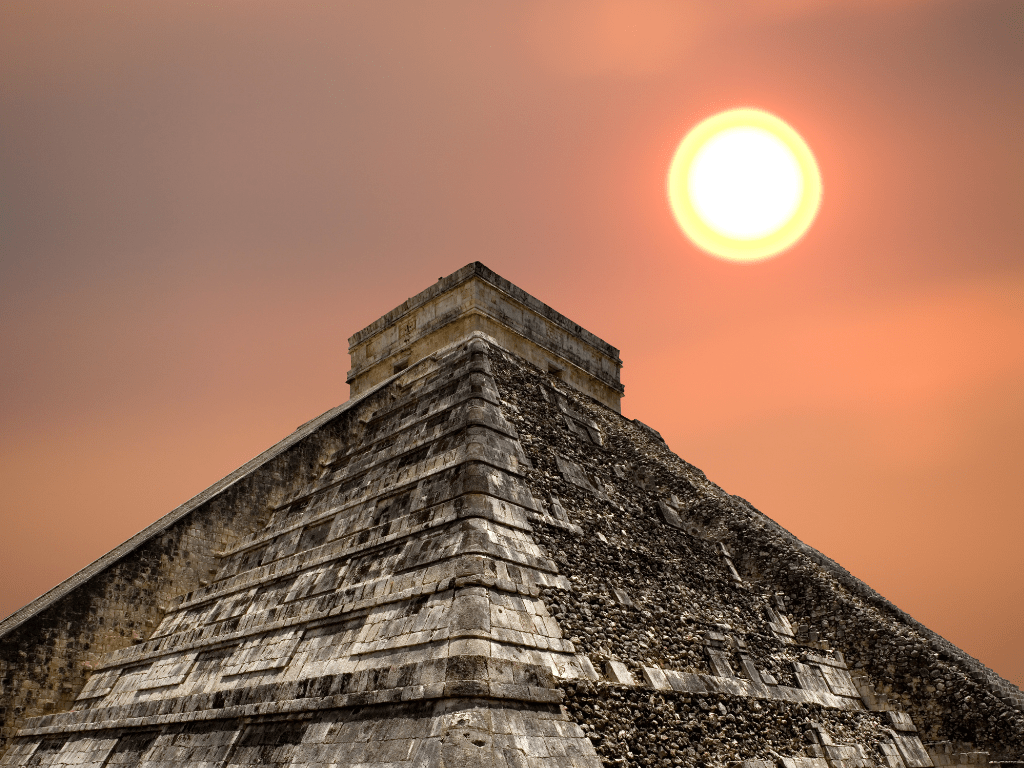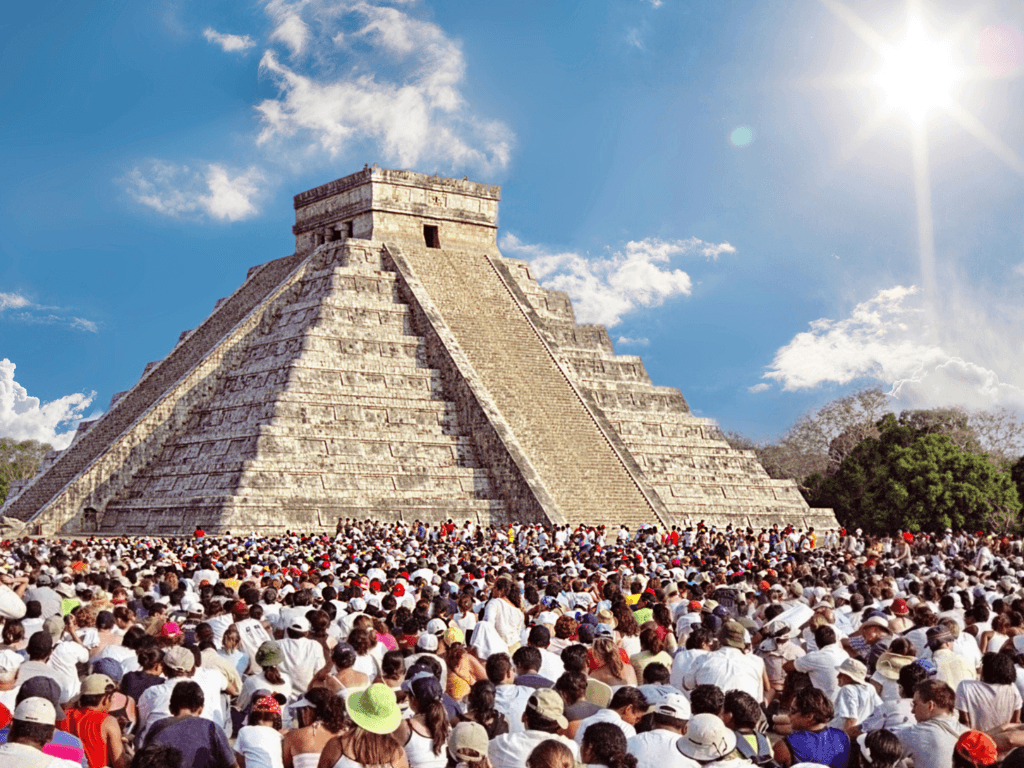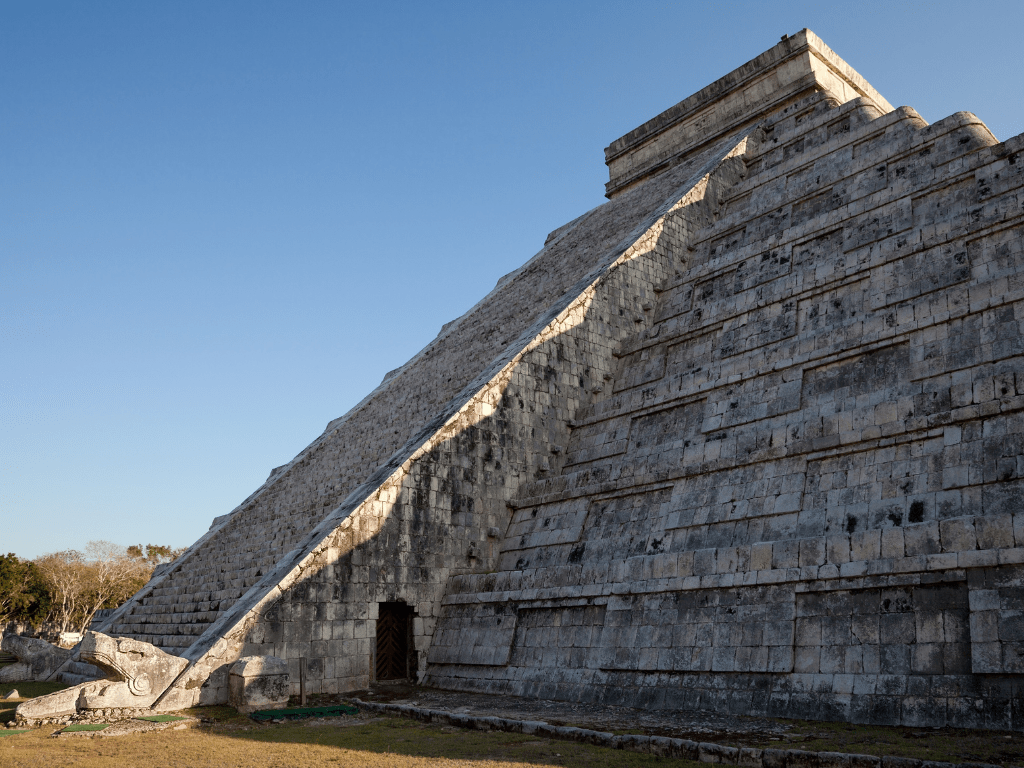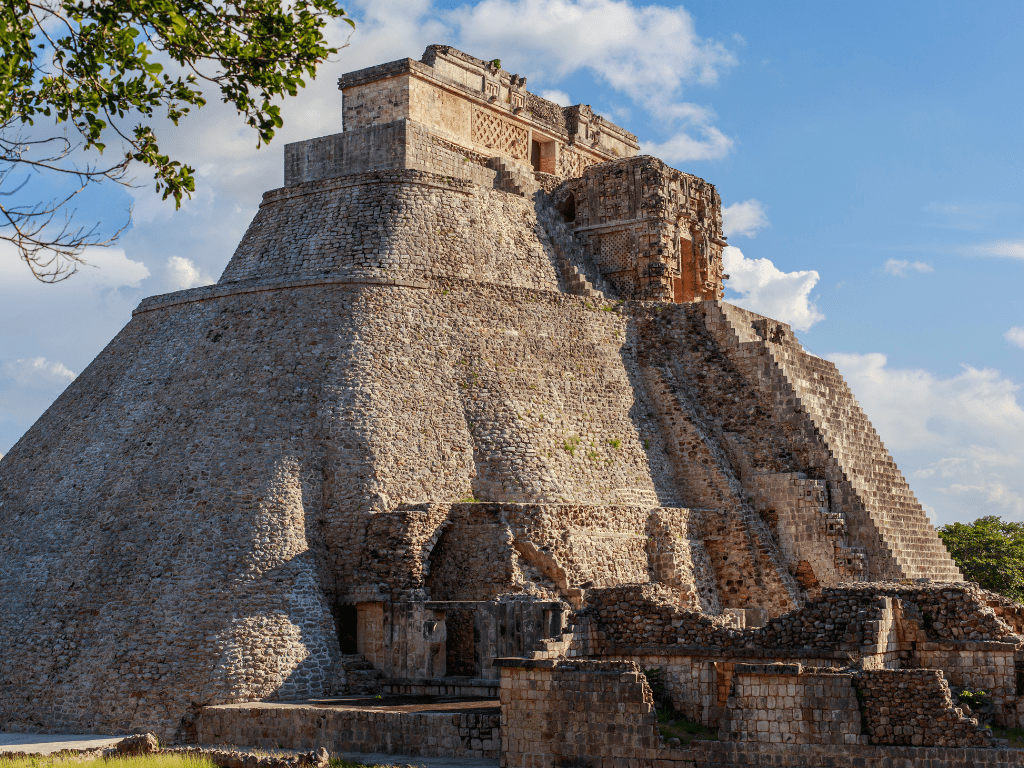Chichen Itza Equinox

Brief History of Chichen Itza
Chichen Itza, located in Mexico’s Yucatan Peninsula, is a pre-Columbian city constructed by the Maya civilization. The city was once a thriving center of culture and trade, and today it is one of Mexico’s most popular tourist destinations. The site covers an area of approximately 6 square miles and contains impressive architectural structures such as the Temple of Kukulcan, known as El Castillo.
Chichen Itza was founded around 600 AD, but it wasn’t until around 900 AD that it became a dominant political and economic power in the region. The decline of Chichen Itza began around 1100 AD, although some estimates suggest that the city was occupied until as late as 1440 AD.
Explanation of the Equinox Phenomenon
The equinox occurs twice a year when day and night are nearly equal in length all over the world. This phenomenon happens because Earth’s axis is tilted neither toward nor away from the sun during equinoxes.
In March or September every year on these very special days at Chichen Itza ancient Mayans observe a unique astronomical phenomenon where sunlight casts shadows that resemble serpents on El Castillo’s staircase. The serpent’s shadow appears to gradually undulate down one side of the pyramid steps on one specific day at dawn during each equinox illumination event.
This effect is created by sunlight casting shadows on different parts of the steps at different times due to their shape. As light touches different corners or edges with rising sun throughout this special day, slithering shadows appear to undulate down along with gradual movement.
Importance of Equinox to Mayan Culture

For ancient Mayans who constructed these amazing structures with complex astronomical alignments, the equinox served as an essential marker in their calendar, marking the beginning of a new season. Their observation of this natural event allowed them to track the progress of crops and determine when to plant and harvest. This valuable knowledge allowed Mayans to thrive in their environment while also developing a highly sophisticated system of math, astronomy, and writing.
Ancient Mayans believed that the serpent shadow was a symbol for Kukulcan or Quetzalcoatl—the Feathered Serpent God—which held great importance in their religious beliefs. The sighting of this shadow during equinoxes was considered a blessing from their gods.
Chichen Itza’s El Castillo pyramid remains one of Mexico’s most emblematic images representing ancient Mayan culture. The pyramid’s alignment with the sun during equinoxes demonstrates not only their incredible architectural skill but also highlights their intricate understanding and use of astronomy.
The celebration of Chichen Itza Equinox is not just about observing a fascinating natural phenomenon but it highlights how deeply rooted ancient Mayan culture is with nature around them. The ceremony represents an opportunity for visitors to experience and learn about the one-of-a-kind connection between ancient people and the cosmos they lived under so long ago.
Overview of Chichen Itza Equinox

Every year, on March 20th and September 22nd, thousands of people from all over the world gather at Chichen Itza to witness a remarkable phenomenon: the equinox. During this event, the shadow of the sun creates an illusionary image of a serpent slithering down the steps of El Castillo pyramid. The phenomenon occurs due to the alignment of the sun with the structure’s nine-tiered pyramid and its ground-level platform.
Date and Time of the Equinox Event
The equinox occurs twice a year: during spring (usually March 20th) and fall (usually September 22nd). The exact time varies slightly each year due to variations in Earth’s orbit around the Sun. In 2021, for example, it occurred at approximately 5:37 AM local time in Chichen Itza.
Location and Setting for the Event
Chichen Itza is located on Mexico’s Yucatan Peninsula, about two hours west of Cancun by car. The site is situated in a dense jungle area surrounded by lush vegetation, which creates a mystical atmosphere during sunrise. Visitors can witness this phenomenon from anywhere within El Castillo’s main plaza.
Activities and Rituals Associated with the Event
The equinox is not just an astronomical event but also an important cultural celebration for Mayan people. Local guides offer tours that explain how Mayans studied astronomy using simple tools such as sticks and shadows to predict weather patterns, planting seasons, crop fertility rates, among others. During this period visitors can participate in guided meditation sessions or traditional dances.
As night falls over Chichen Itza on equinox day there are special events which take place such as traditional dance ceremonies by local Mayan groups or musicians playing traditional instruments. In addition to learning about the Mayan culture, there are also plenty of recreational activities to enjoy at Chichen Itza.
Visitors can explore the site’s many temples and pyramids, including the iconic Kukulcan Temple or discover other structures such as The Great Ball Court which has measurements that demonstrate advanced knowledge of geometry. Overall, experiencing the equinox at Chichen Itza is a unique opportunity to witness an extraordinary astronomical event while immersing oneself in ancient Mayan culture.
The Significance of Equinox at Chichen Itza

The equinox is a phenomenon that occurs twice a year when the sun is directly above the earth’s equator, resulting in equal hours of daylight and darkness. This event has been celebrated by various cultures throughout history, and the Mayans were no exception. For them, the equinox was an important astronomical event that had deep mythological and cultural significance.
The Meaning Behind the Serpent Shadow
One of the most striking features of the equinox at Chichen Itza is the serpent shadow that appears on the side of El Castillo, also known as The Temple of Kukulcan. As the sun sets on this day, a series of triangles appears along one side of the pyramid, creating an illusion of a serpent slithering down its steps.
This phenomenon lasts for only a few minutes and is believed to represent Kukulcan – one of their most important deities. According to Mayan mythology, Kukulcan was a feathered serpent who brought wisdom and knowledge to his people.
He was associated with water, fertility, and agriculture – all essential elements for survival in ancient times. The appearance of his shadow during the equinox was interpreted as a sign that he had returned to Earth once again.
How It Relates to Mayan Mythology

The Mayans were deeply connected to their gods and goddesses through religion and mythology. They believed that everything in nature had spiritual significance and that their gods could be found in natural phenomena such as celestial events like eclipses or stars aligning with certain structures.
The appearance of Kukulcan’s shadow during the equinox was not just about celebrating his return but also about connecting with him spiritually. The serpent was seen as a powerful symbol representing rebirth, renewal, transformation – all themes associated with this time when daylight and darkness are in balance.
The Role of Astronomy in Mayan Culture
Astronomy played a crucial role in Mayan culture, as it helped them to navigate across oceans, track the seasons for planting crops, and create accurate calendars. It is believed that their knowledge of astronomy was unparalleled among ancient civilizations.
Mayan astronomers were able to predict celestial events with great accuracy and used this knowledge to create their intricate calendar system. The equinox was just one example of how they used astronomy to mark important dates and honor their deities.
The Spiritual Significance Today
Today, the equinox at Chichen Itza continues to draw crowds from all over the world as people seek to witness this extraordinary event for themselves. While some may come for the spectacle, others come seeking spiritual connection with Kukulcan and the ancient Mayans.
The significance of the equinox at Chichen Itza goes beyond what meets the eye – it is a reminder of a time when humans were more connected to nature, treated it with reverence and respect, and valued its mystical qualities. It also serves as an inspiration for us today to reconnect with our own spirituality and find meaning in these moments of balance between light and darkness.
Preparation for Equinox at Chichen Itza
Planning and logistics for visitors
Chichen Itza is a popular tourist destination, especially during the equinox. Hence, it is essential to plan your visit ahead of time to avoid any inconvenience.If you’re already in Merida, you best make it to Chichen Itza.
Firstly, you must purchase your tickets beforehand as they are limited and sell out quickly. Secondly, it is advisable to arrive early in the day as parking spaces fill up quickly.
It is important to note that Chichen Itza has strict rules that visitors must follow, such as no smoking or drinking within the park premises. Additionally, visitors cannot bring any food or drinks inside the park; however, there are plenty of food vendors outside near the entrance.
Safety precautions during the event

While experiencing the equinox at Chichen Itza can be exciting and awe-inspiring, visitors must ensure their safety throughout their visit. The park can become crowded during peak hours; hence it is recommended to keep track of your belongings and avoid carrying anything valuable.
Furthermore, it’s hot and humid in Yucatan at this time of year so be sure to wear loose-fitting clothing made from breathable materials like cotton or linen. Also, carry sunscreen & sunglasses with you if you plan on being outside for an extended period.
It’s worth noting that climbing up Chichen Itza’s structures can be challenging for some people due to steep stairs and narrow walkways. Therefore exercise caution while exploring this magnificent ancient city.
Tips for experiencing Equinox at Chichen Itza
Experiencing the equinox at Chichen Itza can be a once-in-a-lifetime experience so take full advantage of this opportunity! Here are some tips for making your visit unforgettable:
– Bring a camera: Capture memories of this breathtaking event by taking photos or videos of serpent-shaped shadows moving down Chichen Itza’s El Castillo pyramid. – Hire a guide: Engage a knowledgeable guide to learn about the history and significance of this ancient Mayan city.
– Relax and enjoy the experience: Take the time to enjoy this incredible event in all its glory! Sit back, relax, and marvel at how ancient civilizations were able to create such precise astronomical aligning structures.
– Attend other events: There are other activities besides the equinox that visitors can partake in while visiting Chichen Itza. These include sound & light shows as well as cultural tours of local villages.
Visitors must plan their trip ahead of time to ensure everything runs smoothly during their visit. Follow safety precautions while exploring the park and take advantage of different activities available during your visit.
The Power of Sound during the Chichen Itza Equinox

The Chichen Itza Equinox is a spiritual experience that celebrates the balance between light and dark. The powerful energy created by this event is believed to be amplified by sound, which is why music and chanting play a significant role in the celebrations. The Mayans were known for their intricate musical instruments, such as drums and flutes, which were used to create a hypnotic rhythm that would elevate participants’ consciousness.
Visitors to the site report feeling deeply moved by the sounds during the equinox. According to Mayan beliefs, sound connects humans with divine forces and creates a harmonious vibration that unites people.
During the equinox, visitors are encouraged to bring musical instruments such as drums or flutes so they can participate in this sacred practice. Throughout the day, different groups will gather around different structures at Chichen Itza to play music together and experience this powerful energy.
The Meaning Behind Each Structure at Chichen Itza during Equinox
Chichen Itza features several buildings specifically designed for astronomical observations. Two of these structures – El Castillo (The Castle) and Temple of Kukulkán – are perfectly positioned for observing sun shadows on each equinox day. This alignment creates a spectacular display as it appears like a snake slithering down one of these pyramids.
El Castillo stands at 79 feet tall with four sides containing 91 steps each adding up altogether totaling 364 plus one hidden step on top which makes it 365 steps similar to the number of days in a year. These numbers represent Mayan agriculture systems; while one hidden step represents an extra day during leap years.
The Temple of Kukulkan is also known as The Temple of Feathered Serpent or El Caracol (the snail). Its position was meant for astronomical observation allowing prediction of rainfall patterns crucial for agricultural production.
The temple also features a unique acoustic design, which creates an echo when standing inside. The Great Ball Court is another structure that attracts visitors during the equinox due to its unique acoustics.
Designed for a Mayan version of basketball, this court has an unusual shape and size that creates a unique acoustic resonance. Visitors can clap their hands at one end and hear the sound perfectly clear at the other end 500 feet away.
How Technology Predicts Exact Timing for Equinox

The Mayans were known for their advanced astronomical knowledge; they could predict solar eclipses with great accuracy using simple methods such as obelisks or shadow measuring instruments. But nowadays, with technological advancements, predicting the exact date and time of the equinox has become more precise.
Using modern technology such as GPS, satellite images and computer simulations, scientists can predict with great accuracy when exactly the sun will appear on each side of El Castillo or Temple of Kukulkán. This information allows Chichen Itza officials to plan and prepare effectively to accommodate thousands of visitors who come from all around the world to witness this significant event.
With these predictions becoming more accurate each year, scientists have been able to study ancient Mayan techniques in predicting solar events more closely. These studies have helped us uncover more about how they lived their daily lives in harmony with nature while creating impressive structures like Chichen Itza that still stand today.
Chichen Itza Equinox is a true testament to how ancient civilizations like the Mayans were in tune with nature’s cycles and used them in religious practices. While there are many aspects to this event that make it special, from sound vibrations to intricate structures’ symbolism, it ultimately represents a celebration of balance between light and dark forces within oneself and outside our world. This extraordinary experience continues its legacy today attracting visitors from all over who wish to bear witness and connect with the powerful energy Chichen Itza has to offer.
Rarely Known Small Details on Equinox at Chichen Itza
The Use of Mirrors by Ancient Mayans to Enhance Sunlight
While the serpent shadow phenomenon is the most famous aspect of the equinox at Chichen Itza, there are many other fascinating details that are not as well-known. One such detail is that ancient Mayans used mirrors to enhance the sunlight during these events. Researchers believe that they may have used a type of polished obsidian stone as a mirror to reflect and focus sunlight onto specific areas of their buildings.
This use of mirrors was likely part of an effort to amplify the effect of the serpent shadow, which would have been even more powerful with brighter light shining on it. The mirrors may also have played a role in certain rituals or ceremonies associated with the equinox.
How to Use Mirrors?
The use of mirrors by ancient Mayans is not unique to Chichen Itza – there is evidence that they were used in other Mayan cities as well. However, their precise function and significance are still not fully understood by researchers.
One theory is that they were used in solar observatories – structures designed specifically for observing astronomical events like equinoxes and solstices. The mirrors could have been used to align with specific points in the sky or reflect sunlight onto certain areas within these structures.
Another possibility is that they were used for more practical purposes, such as starting fires or signaling between different parts of a city. Regardless, their use during equinoxes adds yet another layer of complexity and mystery to this already fascinating event.
Conclusion
The equinox at Chichen Itza is one of the most intriguing astronomical events in human history. From its significance in Mayan mythology to its stunning visual displays, it continues to captivate people from all over the world.
While much has been written about this event, there are still many mysteries and lesser-known details that remain to be explored. By delving deeper into these rarely discussed aspects of the equinox – such as the use of mirrors by ancient Mayans – we can gain a richer understanding of its cultural and scientific significance.
In doing so, we can develop a deeper appreciation for this remarkable event and the people who created it. Ultimately, the equinox at Chichen Itza is a testament to humanity’s enduring fascination with the cosmos and our ongoing quest to understand our place in it.
If the Chichen Itza equinox is not enough for you, come explore other Yucatan adventures.


